Cooking With Rum, The American Spirit
by Emerson Beyer
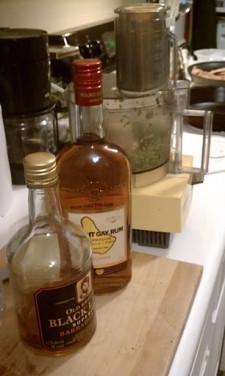
The slide into winter, with woodsmoke curling in the air and the last vivid leaves clinging to the branches, doesn’t necessarily evoke the usual menu of rum cocktails. The mai tai, the daiquiri, the hurricane — they each want a fruit garnish and a tiny parasol. Yet on the cusp of our annual remembrance of the nonviolent collaboration between European settlers and American natives, rum is in fact the perfect commemorative liquor.
When the New World turned out to be devoid of commodities, the colonists turned to tobacco and sugar (brilliant!) to make their stakes worthwhile. Remember the “Rum Triangle?” It was the delightfully efficient trade circuit whose corners were sugar, rum and… something else, possibly bread pudding, I just don’t remember right now. Who needs to dwell on the ugly details of American history anyway? Let your Occupy friends handle that — we have holidays to celebrate!
The rum-filled diet, through savor and intoxication, makes American history a little more palatable. With true respect, a rum menu highlights native flavors from the whole range of those early encounters — cranberries (from northern bogs), allspice (from the Antilles) and pumpkin (from Central America originally).
For all these recipes, I used easy-to-find, inexpensive Barbadian rum, because it’s much more flavorful than Puerto Rican rum (blame Bacardi for monopolizing the production there) and, if not as great as some of the small-production rums out there, it’s definitely good enough to drink, and you won’t feel you’re wasting it by putting it in food, in hot cider — or in this delicious, déclassé punch.
Getting Lit, Once Again
Making a simple fruit compote with rum is a great way to make a fall dessert if you don’t have the time and inclination to do a pie. This weekend, I diced a “sugar pie” pumpkin (not a carving pumpkin — they are not the same) and poached it in butter with brown sugar over low heat until it was very soft; this takes at least 40 minutes. Do you remember how to flambé? I added about half a cup of rum, let it get nice and hot, then set the whole pan on fire until the flame died. Then I made a parfait of pumpkin compote, crushed ginger snaps and whipped cream — the essence of pumpkin pie distilled for a weeknight.
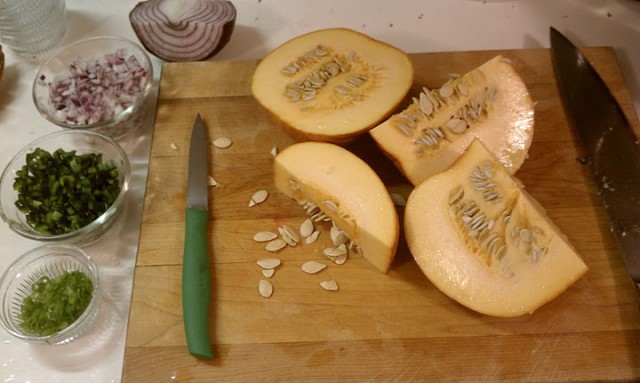
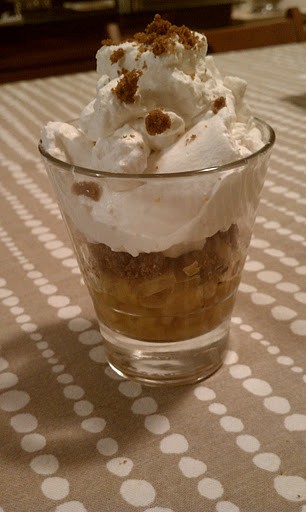
Let’s say you do want to make a pie, but, anticipating the regime of Tradition that Thanksgiving brings, for now you don’t want to do a straightforward apple or pumpkin pie. You can use essentially the same compote as above, using pumpkin or apple — though I would slice the fruit very thin instead of dicing it before poaching and flambéing. Make a pie crust — either the traditional dough kind or a cookie crumb kind. Bake it. Then make rum pastry cream using the same technique we learned before. Fill the crust with the pastry cream and carefully top it with your cooked fruit. Don’t apply the fruit too early or with too much of the pan sauce, or you’ll get a wet mess.
Oh, do you know how to make a cookie crumb crust? The main thing to know is the ratio of ½ pound cookies (graham crackers, ginger snaps, vanilla wafers, anything), pulverized, to ¼ pound of butter, melted and not cooled. Mix thoroughly in your biggest bowl. Then push it into the pie pan. Even if it seems like it’s not going to hold together, be patient — time and the cooling of butterfat will make it whole. You don’t technically need to bake this, but a few minutes in the oven will make the cookies taste fresher and the butter permeate everything more completely.
Hot In November
Did you know that Christopher Columbus spent all of November 1493 sailing around the Lesser Antilles? And that he brought back allspice berries from that trip? And did you also know that allspice berries are a key flavoring in the Jamaican cuisine called ‘jerk’? Oh, and that a jerk sauce is a great way to use rum?! All these happy coincidences! It’s as if the Taino people that Columbus, uh, met on that trip are watching over us benevolently.
A delicious, simplified jerk marinade/sauce is so good on grilled chicken or tofu. This is not an “authentic” jerk seasoning, nor is this really jerk cooking — if you want to learn the real deal I’m sure there’s a class or a winter break immersion trip for that. This recipe is easy to learn and has all the hallmarks of jerk flavor, and I don’t think it will disappoint any non-Jamaican palate.
Here’s my mnemonic device for remembering how to make jerk sauce: think of it as a marriage. On the bride’s side is spice, and on the groom’s side are vegetables. You need only three crucial ingredients on each side:
• Bride’s side: one tablespoon allspice; one or two nutmeg nuts, crushed with a nutcracker or clean pliers; and one or two sticks of cinnamon, broken into pieces.
• Groom’s side: two super-hot chili peppers (Scotch bonnet is traditional, but habanero is just as good, and know your own Scoville tolerance); two or three peeled cloves of garlic, depending on the size and piquancy; and a typical grocery store bunch of green onions, approximately six.
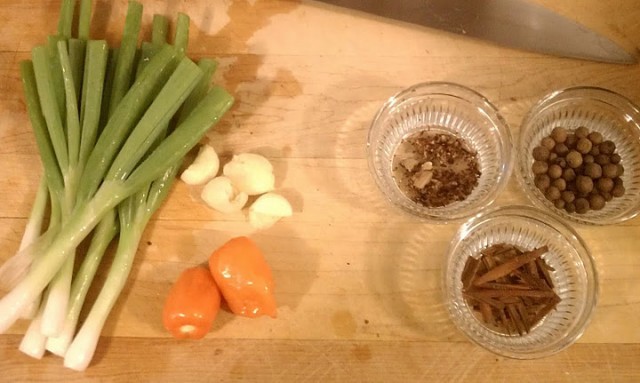
It’s not necessary but not a bad idea to grind up the spices in a spice grinder if you have one. Trim the dark green parts from the onions and cut the remainder into small pieces. Put everything in the food processor with a little olive oil to get things mixing and moving. Add ½ cup of rum — rum is the officiant at this wedding! — and process until smooth.
As I noted, this is both a marinade and a sauce, so make sure the meat is nice and saucy when it’s time to cook. The longer you marinade, the more of the heat from the chilies (capsaicin) will get into your meat — the minimum time is a few hours, but overnight rest in the fridge will provide you the full jerk experience. When cooked over high heat, especially with some smoke, the allspice comes through more than the chilies, and you get a flavor that’s very lively but not overwhelming.
Adaptive reuse alert: I used the pumpkin compote from dessert, above, as a condiment on my jerk chicken.
To go along with this chicken I made rice with fennel, sausage and rum-soaked raisins. Rum is somehow great for plumping up dried fruit; just remember to do it ahead of time, because it takes a few hours to soak in. I add a pinch of brown sugar and a squeeze of lemon so that the result isn’t excessively boozy.
To make this rice dish, start by cutting up a fennel bulb into small pieces and softening it in oil over medium-low heat (ten minutes or so). Add salt, white pepper, ground coriander and two broken cardamom pods along with the rice. The amount and kind of rice you use is totally a matter of preference. If I have an hour to cook, I use brown basmati because it’s delicious, but it takes a long time to cook. Anyhow, stir that rice with in the oil and other ingredients for a minute, and then add water. Bring it to a boil, then turn down the heat and leave it covered for… as long as it takes your rice to cook! Meanwhile, take one or two links from America’s great diversity of sausage out of its casing (I used andouille, but Mexican-style chorizo would be equally great), fry it up, and then stir it along with the rum-soaked raisins into the cooked rice.
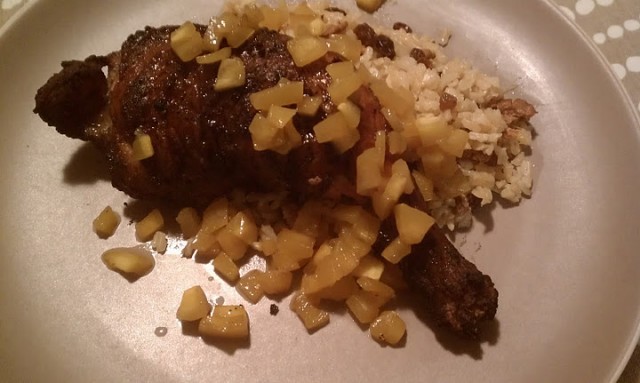
Swine played a big role in the American colonial period. Wild hogs provided emergency food for the settlers of Jamestown. Pigs introduced by Columbus quickly became a staple meat of Caribbean diets. Try not to think about the ongoing environmental and social consequences of that, and focus instead on the indisputable beauty of pork spare ribs braised in rum and lime juice! Salt and pepper the ribs, then sear the meaty side in a very hot cast-iron pan. Keeping them “face” down, squeeze a few limes into the pan and pour in enough rum so that the meat is mostly immersed; about one cup of rum for a pound of ribs in a 12-inch pan, and this will serve two people. Cover the pan and put it in a 250F oven for an hour. After pulling it off the bones, you can use this pork for tacos or sandwiches, though I have served it with a salad of corn, poblanos and red onion.


Continuing in the spirit of American history — and getting even more expansive — let’s not forget quinoa, the Incan grain that (unlike rice) doesn’t require a lot of interventions to be tasty, and also cooks pretty quickly compared to brown rice. The key to delicious quinoa is dry-toasting it before cooking. It’ll take about five minutes in a pan over medium heat to get it a nice golden color. Then continue with the rest of your cooking plan.
Since you have some rum-soaked dried cranberries (right?), you can definitely use them in a delicious November quinoa salad. Coarsely chop about six shallots, then begin to soften them in the pot in a little butter or oil over medium heat. Add a handful of diced pumpkin or other squash, and continue softening for another 10 minutes or until the pumpkin is not fully cooked but soft enough to be edible. Along with some salt, chopped sage, and a scoop of those cranberries, put in a cup of toasted quinoa, two cups of water, bring to a boil, then move to a low burner, cover, and let steam for 20–25 minutes.
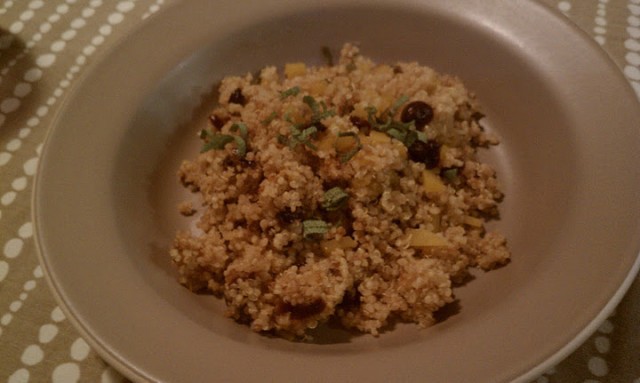
Rum For Breakfast
With the end of Daylight Saving Time, your mornings are brighter, and you are undoubtedly facing your own daily pursuit of the American dream with renewed zeal. Start your day the American way with a bit of rum in your breakfast, a symbolic connection to your brave, blitzed ancestors.
You still have some of those rum-soaked raisins or cranberries, right? Well, bake them into some muffins. Any muffins are good, but I might go for the banana muffins, recalling Bananas Foster, that American original.
Bananas and rum have a long history of their own, and some bananas flambéed with rum (I sincerely hope you’ve mastered the flambé after all our time together) would be a great topping for pancakes. I’d say it would be good on French toast too, but maybe save that one for Canadian Thanksgiving when it rolls around next year.
K. Emerson Beyer, environmentalist and gadabout, lives in Durham, N.C. and tweets as @patebrisee.
